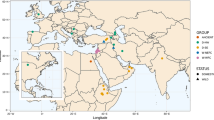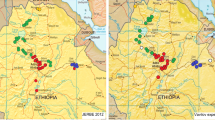Abstract
Emmer wheat, Triticum dicoccon Schrank was one of the founder crops of Neolithic agriculture. Though its cultivation was largely replaced by hexaploid wheats 2000 years ago, pockets of small scale cultivation can still be found. One such area is the Asturias region of Northern Spain, where emmer wheat remains a traditional crop for high value specialist culinary uses, and farmers grow locally adapted landraces. In order to study the diversity of these landraces, we sampled emmer wheat from different regions of Asturias, and genotyped multiple plants from each village using nuclear and chloroplast microsatellites. A high level of variation was observed with markers from both genomes, including a novel chloroplast haplotype. A strong geographic structure was observed in the Asturian emmer wheats in both the chloroplast markers and the nuclear microsatellite data.




Similar content being viewed by others
References
Allender CJ, Allainguillaume J, Lynn J, King GJ (2007) Simple sequence repeats reveal uneven distribution of genetic diversity in chloroplast genomes of Brassica oleracea L. and (n = 9) wild relatives. Theor Appl Genet 114:609–618
Alonso N (2008) Crops and agriculture during the Iron Age and late antiquity in Cerdanyola del Valle`s (Catalonia, Spain). Veg Hist Archaeobot 17:75–84
Alvarez JB, Caballero L, Ureña P, Vacas M, Martıín LM (2007) Characterisation and variation of morphological traits and storage proteins in Spanish emmer wheat germplasm (Triticum dicoccon). Genet Resour Crop Evol 54:241–248
Bonfield JK, Staden R (1996) Experiment files and their application during large-scale sequencing projects. DNA Seq 6:109–117
Bonfield JK, Smith KF, Staden R (1995) A new DNA sequence assembly program. Nucleic Acids Res 24:4992–4999
Brown TA (1999) How ancient DNA may help in understanding the origin and spread of agriculture. Philos Trans R Soc Lond B 354:89–97
Brown T, Lindsay S, Allaby R (2006) Using modern landraces of wheat to study the origins of European agriculture. In: Motley T, Zerega N, Cross H (eds) Darwin’s harvest. Columbia University Press, New York, NY
Brown TA, Jones MK, Powell W, Allaby RG (2009) The complex origins of domesticated crops in the Fertile Crescent. Trends Ecol Evol 24:103–109
Caballero L, Martin LM, Alveres JB (2007) Agrobiodiversity of hulled wheats in Asturias (North of Spain). Genet Resour Crop Evol 54:267–277
Caballero L, Martin LM, Alvarez JB (2008) Genetic diversity in Spanish populations of Triticum spelta L. (escanda): an example of an endangered genetic resource. Genet Resour Crop Evol 55:675–682
Charles M, Bogaard A, Jones G, Hodgson JH, Halstead P (2002) Towards the archaeobotanical identification of intensive cereal cultivation: present-day ecological investigation in the mountains of Asturias, northwest Spain. Veg Hist Archaeobot 11:133–142
Eujayl I, Sorrells ME, Baum M, Wolvers P, Powell W (2001) Assessment of genotype variation among cultivated durum wheat based on EST-SSRs and genomic SSRs. Euphytica 119:39–43
Fahima T, Röder MS, Wendehake K, Kirzhner VM, Nevo E (2002) Microsatellite polymorphism in natural populations of wild emmer wheat, Triticum dicoccoides, in Israel. Theor Appl Genet 104:17–29
Hirosawa S, Takumi S, Ishii T, Kawahara T, Nakamura C, Mori N (2004) Chloroplast and nuclear DNA variation in common wheat: insight into the origin and evolution of common wheat. Genes Genet Syst 79:271–282
Huelsenbeck JP, Andolfatto P (2007) Inference of population structure under a Dirichlet process model. Genetics 175:1787–1802
Isaac AD, Muldoon M, Brown KA, Brown TA (2010) Genetic analysis of wheat landraces enables the location of the first agricultural sites in Italy to be identified. J Archaeol Sci 37:950–956
Ishii T, Mori N, Ogihara Y (2001) Evaluation of allelic diversity at chloroplast microsatellite loci among common wheat and its ancestral species. Theor Appl Genet 103:896–904
Jones H, Leigh FJ, Mackay I, Bower MA, Smith LM, Charles MP, Jones G, Jones MK, Brown TA, Powell W (2008) Population-based resequencing reveals that the flowering time adaptation of cultivated barley originated east of the Fertile Crescent. Mol Biol Evol 25(10):2211–2219
Leigh F, Lea V, Law J, Wolters P, Powell W, Donini P (2003) Assesment of EST- and genomic microsatellite markers for variety discrimination and genetic studies in wheat. Euphytica 133:359–366
Li YC, Fahima T, Peng JH, Röder MS, Kirzhner VM, Beiles A, Korol AB, Nevo E (2000) Edaphic microsatellite DNA divergence in wild emmer wheat, Triticum dicoccoides, at a microsite: Tabigha, Isreal. Theor Appl Genet 101:1029–1038
Lister D, Thaw S, Bower M, Jones H, Charles MP, Jones G, Smith LM, Howe CJ, Brown TA, Jones MK (2009) Latitudinal variation in a photoperiod response gene in European barley: insight into the dynamics of agricultural spread from ‘historic’ specimens. J Archaeol Sci 36(4):1092–1098
Lui K, Muse SV (2005) PowerMarker: integrated analysis environment for genetic marker data. Bioinformatics 21:2128–2129
Martinez NA (2005) Agriculture and food from the Roman to the Islamic period in the North-East of the Iberian Peninsula: archaeobotanical studies in the city of Lleida (Catalonia, Spain). Veg Hist Archaeobot 14:341–361
McCauley DE (1995) The use of chloroplast DNA polymorphism in studies of geneflow in plants. Trends Ecol Evol 10:198–202
Molina-Cano J-L, Russell JR, Moralejo MA, Escacena JL, Arias G, Powell W (2005) Chloroplast DNA microsatellite analysis supports a polyphyletic origin for barley. Theor Appl Genet 110:613–619
Ogihara Y, Isono K, Kojima T et al (2000) Chinese spring wheat (Triticum aestivum L.) chloroplast genome: complete sequence and contig clones. Plant Mol Biol Rep 18:243–253
Oliveira HR (2011) Archaeogenetics and the spread of agriculture in the Iberian Peninsula and Northwest Africa: a study of genetic variation within tetraploid and diploid wheats. PhD dissertation, University of Cambridge, Cambridge, UK
Oliveira HR, Jones H, Leigh F, Lister DL, Jones MK, Peña-Chocarro L (2011) Phylogeography of einkorn landraces in the Mediterranean basin and Central Europe: population structure and cultivation history. Archaeol Anthropol Sci 3:327–341
Peleg Z, Fahima T, Abbo S, Krugman T, Saranga Y (2008) Genetic structure of wild emmer wheat populations as reflected by transcribed versus anonymous SSR markers. Genome 51(3):187–195
Peña-Chocarro L (1996) In situ conservation of hulled wheat species: the case of Spain. In: Padulosi S, Hammer K, Heller J (eds) Hulled wheats: proceedings of the first international workshop on hulled wheats, 21–22 July 1995, Castelvecchio Pascoli, Tuscany, Italy (promoting the conservation and use of underutilised and neglected crops. 4). IPGRI, Rome
Peña-Chocarro L, Zapata L (2003) Post-harvest processing of hulled wheats; an ethnoarchaeological approach. In: Anderson PC, Cummings LS, Schippers TK, B Simonel (eds) Le traitement des recoltes: un regard sur la diversite, du Neolithique au present. XXIII rencontres internationals d’archeologie et d’histoire d’Antibes. Editions APDCA, Antibes
Perrier X, Jacquemoud-Collet JP (2006). DARwin software http://darwin.cirad.fr/darwin
Perrier X, Flori A, Bonnot F (2003) Data analysis methods. In: Hamon P, Seguin M, Perrier X, Glaszmann JC (eds) Genetic diversity of cultivated tropical plants. Enfield, Science Publishers, Montpellier, pp 43–76
Pflüger LA, Martín LM, Alvarez JB (2001) Variation in the HMW and LMW glutenin subunits from Spanish accessions of emmer wheat (Triticum turgidum ssp. dicoccum Schrank). Theor Appl Genet 102(5):767–772
Pritchard JK, Stephens M, Donnelly P (2000) Inference of population structure using multilocus genotype data. Genetics 155:945–959
Provan J, Soranzo N, Wilson NJ, Goldstein DB, Powell W (1999) A low mutation rate for chloroplast microsatellites. Genetics 153:943–947
Provan J, Wolters P, Caldwell KH, Powell W (2004) High-resolution organellar genome analysis of Triticum and Aegliops sheds new light on cytoplasm evolution in wheat. Theor Appl Genet 108:1182–1190
Röder MS, Korzun V, Wendehake K, Plaschke J, Tixier MH, Leroy P, Ganal MW (1998) A microsatellite map of wheat. Genetics 149(4):2007–2023
Schuelke M (2000) An economic method for the fluorescent labeling of PCR fragments. Nat Biotechnol 18:233–234
Sigaut F (1978) Identification des techniques de decolte des grains alimentaires. Journal d’Agriculture Traditionelle et de Botanique Appliquée 25:145–162
Tereso JP (2009) Plant macrofossils from the Roman settlement of Terronha de Pinhovelo, northwest Iberia. Veg Hist Archaeobot 18:489–501
Wolfe KH, Li WH, Sharp PM (1987) Rates of nucleotide substitution vary greatly among plant mitochondrial, chloroplast and nuclear DNA. PNAS 84:9054–9058
Zapata L (2007) First farmers along the coast of the Bay of Biscay. In: Colledge S, Conolly J (eds) The origins and spread of domestic plants in Southwest Asia and Europe. Left Coast Press, Walnut Creek, CA, pp 189–208
Zapata L, Peña-Chocarro L, Pérez-Jordá G, Stika H-P (2004) Early neolithic agriculture in the Iberian Peninsula. World Prehist 18:283–325
Zeder MA, Emshwiller E, Smith BD, Bradley DG (2006) Documenting domestication: the intersection of genetics and archaeology. Trends Genet 22(3):139–155
Zhang LY, Bernard M, Leroy P, Feuillet C, Sourdille P (2005) High transferability of bread wheat EST-derived SSRs to other cereals. Theor Appl Genet 111:677–687
Zilhão J (2000) From the mesolithic to the neolithic in the Iberian Peninsula. In: Price DT (ed) Europe’s first farmers. Cambridge University Press, Cambridge, UK, pp 144–182
Zohary D, Hopf M (2000) Domestication of plants in the old world: the origin and spread of cultivated plants in West Asia, Europe, and the Nile Valley. Oxford University Press
Acknowledgments
This work was funded by the Natural Environment Research Council as part of the consortium project ‘The Domestication of Europe’. We thank the project partners at the University of Cambridge, University of Manchester and University of Sheffield for helpful advice. The consortium consists of Mim Bower (McDonald Institute of Archaeological Research, University of Cambridge, Downing Street, Cambridge CB2 3DZ), Keri Brown (Faculty of Life Sciences, Jackson’s Mill, The University of Manchester, PO Box 88, Manchester M60 1QD), Mike Charles (Department of Archaeology, University of Sheffield, Northgate House, West Street, Sheffield S1 4ET), Sue Colledge (Department of Archaeology, University of Sheffield, Northgate House, West Street, Sheffield S1 4ET), Rachel Giles (Faculty of Life Sciences, Jackson’s Mill, The University of Manchester, PO Box 88, Manchester M60 1QD), Glynis Jones (Department of Archaeology, University of Sheffield, Northgate House, West Street, Sheffield S1 4ET), Huw Jones (NIAB, Huntingdon Road, Cambridge CB3 0LE, UK), Martin Jones (McDonald Institute of Archaeological Research, University of Cambridge, Downing Street, Cambridge CB2 3DZ), Fiona Leigh (NIAB, Huntingdon Road, Cambridge CB3 0LE, UK), Diane Lister (McDonald Institute of Archaeological Research, University of Cambridge, Downing Street, Cambridge CB2 3DZ), Wayne Powell (NIAB, Huntingdon Road, Cambridge CB3 0LE, UK), Lydia Smith (NIAB, Huntingdon Road, Cambridge CB3 0LE, UK), Susan Thaw (Faculty of Life Sciences, Jackson’s Mill, The University of Manchester, PO Box 88, Manchester M60 1QD) and Terry Brown (Faculty of Life Sciences, Jackson’s Mill, The University of Manchester, PO Box 88, Manchester M60 1QD).HO is funded by a Portuguese Science and Technology Foundation doctoral grant (Ref. SFRH/BD/21748/2005). We wish to acknowledge the expertise of Leonor Peña-Chocarro and the generosity of all the farmers who donated material for this research.
Author information
Authors and Affiliations
Corresponding author
Electronic supplementary material
Below is the link to the electronic supplementary material.
Rights and permissions
About this article
Cite this article
Leigh, F.J., Oliveira, H.R., Mackay, I. et al. Remnant genetic diversity detected in an ancient crop: Triticum dicoccon Schrank landraces from Asturias, Spain. Genet Resour Crop Evol 60, 355–365 (2013). https://doi.org/10.1007/s10722-012-9840-8
Received:
Accepted:
Published:
Issue Date:
DOI: https://doi.org/10.1007/s10722-012-9840-8




